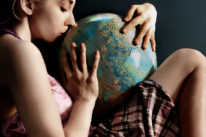
“Where there is anger, there is always pain underneath.” ~Eckhart Tolle
“I don’t know why I’m so angry,” my mother said.
It was 3 a.m., and my mother was standing outside my door. I had awoken suddenly to hear feet stomping up and down the hallway on one of my last visits to my childhood home before dementia and breast cancer really took hold of her.
“Phht, me either.” I tried to empathize, but inside of me rose my own fear and anger, as my siblings and I had watched her decline over the years, yet at the same time, anger was not new to her.
Today, when I think back on this night and so many others like it, the question that I ask now is not “Why are you so angry?” but “Why are you not angrier?”
The truth is, I didn’t see a lot of anger in my family growing up, but being a highly sensitive person, I felt it all. I saw the occasional outburst, but I felt every one of my mother’s facial expressions, tones, and movements that signalled distress. I felt it in the room, along with the myriad of other emotions that human nervous systems naturally feel but have learned so well are not always appropriate.
Two things I did see and feel were love and happiness, so I am grateful for that. But we are so much more than that.
My suppression of anger was learned very young. If you don’t see something reflected in the mirror around you, it can’t exist.
I remember so clearly, when I was thirteen, my mother came home from the hospital after her first partial mastectomy with a drainage tube attached to her chest.
We sat in the living room as it was explained to us, as children, what had happened.
I don’t remember the word cancer, but as a child, I could have blocked it or simply just not understood.
What I do remember is the feeling in my body. I can still feel it now. The rising sensation of tightness and contraction that rose up into my throat and begged for expression. But as I looked around the room, I couldn’t see that sensation anywhere else.
I remember pursing my lips together, probably tightening my jaw to reinforce the guards in case the tightness burst out into the room.
It was one of the most confusing moments of my life. I understand it now.
The news felt big and the emotions felt big, as did the overlay of rage—at the situation, others, or myself; I don’t know which. But it had nowhere to go. I felt suffocated.
I excused myself to “go out with my friends,” which must have seemed like an odd response, but it was the only thing I knew how to do. I didn’t go out with friends. I escaped into the cold night air so I could breathe. I walked and walked, unconsciously moving through an internal freeze.
The emotions never seemed to go away; they only seemed to thicken as I developed more and more armor. I learned that escaping felt good. I loved my family deeply, so it didn’t make sense to me when I felt relief to leave the house and go out drinking with friends.
It wasn’t just moving toward pleasure as a teenager; it was avoidance of pain.
I disconnected more and more from myself and my internal turmoil, and the mask on my outside grew more and more protective, smiley, and sturdy. It became who I was.
Repressing my anger, sadness, and fear felt like the only option, yet it was literally killing me inside as I developed the opposite expression of external perfectionism.
Flawless, nice, smiling, impeccably high standards on the outside.
Complete chaos and a raging inner critic on the inside.
This growing monster morphed into the extreme control of an eating disorder that nearly took my life. The binging and purging of bulimia felt like feeding an insatiable hunger followed by a complete release and restabilization of the perfection.
In retrospect, I see this was a young girl’s own internal method of coping and self-regulation. Of course, in reality, it was anything but.
Thanks to an attuned and compassionate doctor, I was able to finally be seen and heard as someone who was more than an acting-out teen, who was really in trouble. This was the turning point, and I wish I could say it all turned around, but the journey ahead of me was long.
The road to healing has been one of reclamation.
Slowly reclaiming my body, piece by piece. Nurturing and nourishing her and paying attention to her needs. Including those parts society has deemed not right or unacceptable.
Reclaiming and feeling my emotions, all of them. But mostly reclaiming my right to anger.
During my forties, when I experienced a period of burnout, I realized that anger was the last stone to uncover. I had been skirting around it for decades.
Even as a yoga and mindfulness student and teacher, I never went into the energy of anger fully, always instructed to notice and surf the emotions on the way to peace and happiness.
Yet anger was the part of me that needed self-love more than anything else. And the rewards anger gave me in return were not what I expected.
I did not become an angry person. I became a more confident and powerful person who rose above shame and people-pleasing. I set boundaries more easily because I loved myself more. It gave me back my wholeness.
Access to the energy of anger also afforded me access to the opposite end of the emotional scale: excitement and enthusiasm.
Research now clearly tells us that repressed anger can contribute to anxiety, depression (repression), chronic illnesses, fatigue, and pain, and I can feel the truth in that.
But we have learned very well how to cope. We rationalize (it’s not that bad), minimize (other people have it so much worse), and desperately escape ourselves looking for worth in people-pleasing, validation, praise, and permission.
We leave our bodies in search for perfection that doesn’t exist and end up continually feeling not smart enough, thin enough, healthy enough, young enough, or good enough.
The fear of expressing anger is compounded by being labeled as “angry,” which leads to further invalidation and invisibility. That is only what happens if you stay stuck in the stories of blame.
I uncovered my capacity to befriend anger safely and harness its power to speak, protect, and stand up for myself from a place of self-love.
I now know that:
- Anger is the energy of healthy entitlement that says, “I have a right to be here” and speaks up against injustice from a place of ultimate, fierce love.
- Anger is the energy of healthy aggression that protects your own worth and naturally sets boundaries that protect your body, time, and energy.
- Anger is the place that defines clearly what you value and what you stand for and love.
- Anger is the healing we need to step out of the program of perfectionism and the “good girl” (or boy) into our true, whole, authentic aliveness.
I love anger in all its forms. It is a mobilizer for good in the world, and if you are reading this, I’m guessing you are not someone who will use it in toxic ways for war and destruction.
You can harness it in small ways to access the true power of your voice, your breath. and the full capacity of fierce love.
There is often a pot of stored anger to drain first so you can then move through it gently, lovingly, and listen to its valuable messages. To do this:
- Notice where and when you tighten, contract, or feel annoyed or irritable.
- Breathe into those areas in your body to create space around them.
- Inhale and contract right into the areas of anger, including your hands and feet, and then release it with a sigh, sound, scream, or growl.
- Notice what anger is pointing you toward: What needs to be protected that you value? What do you need? What needs to be said? What do you miss or grieve or worry about? See what rises now.
Remember, you are a living, growing, learning, and expanding human, and we can heal not in spite of our anger, but through it.
About Madeleine Eames
Madeleine is an author, therapist, mindfulness teacher, and breathwork guide. Her mission is to inspire women at midlife to release old patterns and beliefs to rebirth themselves and live their most free and authentic lives. The Expansion Blueprint course for women to heal and expand into themselves begins February 6th. She can be found at her Youtube channel Woman Fully Alive or at her website mindfullivingnow.com. Join Madeleine’s upcoming Emotional Release Breathwork Class.
- Web |
- More Posts













 Though I run this site, it is not mine. It's ours. It's not about me. It's about us. Your stories and your wisdom are just as meaningful as mine.
Though I run this site, it is not mine. It's ours. It's not about me. It's about us. Your stories and your wisdom are just as meaningful as mine. 